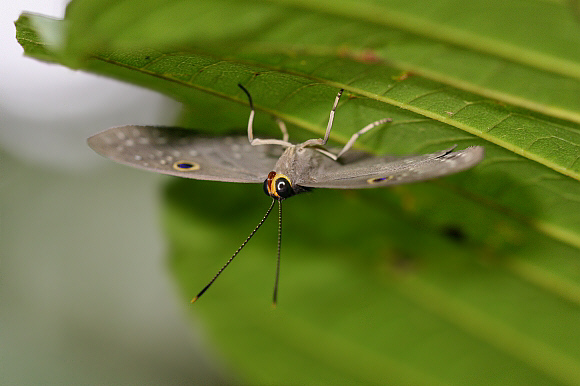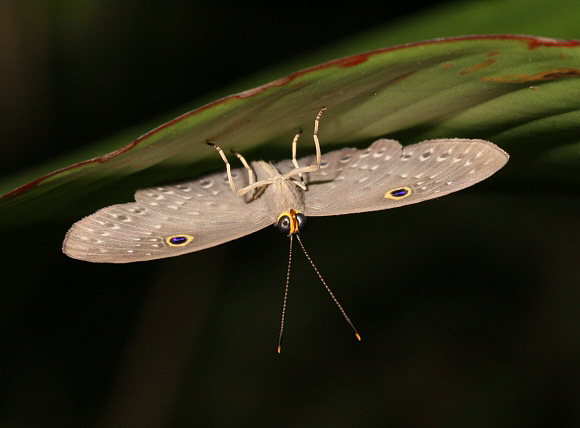 Eurybia caerulescens, Rio Pindayo, Peru – Adrian Hoskins
Eurybia caerulescens, Rio Pindayo, Peru – Adrian Hoskins
Introduction
There are about 20 Eurybia Underleaf butterflies, which occur variously throughout the neotropics from Nicaragua and Honduras to southern Peru and Bolivia.
All have greyish or brownish uppersides with a series of squarish submarginal markings. Several species e.g. molochina and lycisca have a blue iridescence across the upperside hindwings. Almost all species have a prominent orange-ringed false eyespot in the discal cell of each forewing. Only halimede, albiseriata, elvina and the falcate-winged carolina and pergaea lack these eyespots, and hence are commonly known as “blind” underleafs. In all species the upperside pattern is repeated on the under surface, but the under surface is paler, and the markings less conspicuous.
Other Eurybia characteristics include metallic green eyes and an extremely long proboscis that is almost twice the length of the body, enabling the butterflies to reach deep into flowers for nectar.
Eurybia caerulescens is found in the upper Amazonian rainforests of Peru, and probably also in nearby regions of Ecuador, Brazil and Bolivia.
Habitats
This species occurs in primary rainforest at elevations between about 200-400m. The butterflies are never seen in open sunlit areas, instead preferring the darkness of the forest understorey.
Lifecycle
I have no data regarding caerulescens but the lifecycle is likely to be similar to that of other Eurybia species as follows: The eggs are like flattened lozenges and are laid singly on the stems and leaves of Calathea, Ichnosiphon, Maranta, ( Marantaceae ), Costus and Renealmia ( Zingiberaceae ). The larvae are maggot-like, and feed on the flowers, not the foliage. Older larvae can be found in ant nests within sheaths surrounding the stems of the foodplants. They are constantly attended by ants which milk them for a sugary substance secreted from a dorsal gland. The larvae are parasitised by Rogas and other Braconid wasps.
The proboscis on the butterflies is very long, and there is a correspondingly long-proboscis casing on the pupa, which extends about 2cms beyond the tip of the abdomen.
Adult behaviour
The adults are very secretive by nature, spending long periods resting under the leaves of low growing vegetation, with wings spread open, while almost cheekily peering out to keep a watchful eye on human intruders. Periodically they dash out to investigate other butterflies, but instantly return to settle under another nearby leaf. The speed of flight is extraordinary, and the degree of agility apparent when they fly into the vegetation, flip upside-down and settle under a leaf is quite amazing to behold.
All Eurybia species have an extremely long proboscis which enables them to probe for nectar into the deep flowers of Heliconia plants. The easiest way to observe the butterfly is to find an isolated Heliconia growing in the forest, and to wait nearby until one arrives.
DeVries records that large numbers of Eurybia adults are eaten by Anolis and Norops lizards.

Eurybia caerulescens, Rio Pindayo, Peru – Adrian Hoskins
